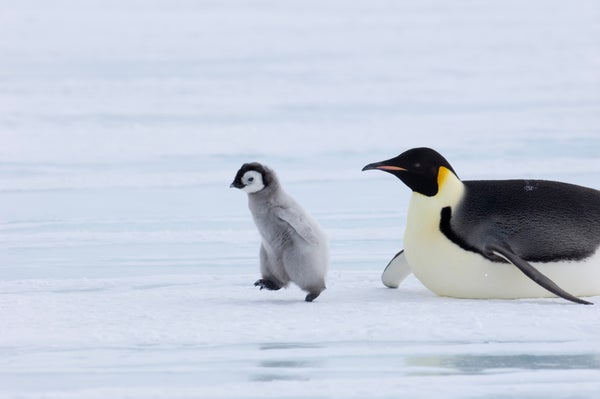Disappearing sea ice is taking a toll on the youngest members of the largest species of penguins, new research finds.
Emperor Penguins (Aptenodytes forsteri) are born into the darkness of Antarctica’s long winter and then fledge around December, when the days of the Southern Hemisphere’s summer are longest. Until fledging—when growing penguins get the slick feathers that keep them warm in frigid waters—chicks are confined to the sea ice and fed by their parents.
But these birds’ crucial nursery is literally disappearing under their feet. In 2022 Antarctica saw record-low levels of sea ice, and scientists now say Emperor Penguins consequently lost chicks across the continent. The birds faced their first regional disaster around the Bellingshausen Sea, located to the west of a long peninsula that stretches north from West Antarctica. Here four of five local Emperor Penguin colonies—about 10,000 breeding pairs—likely saw all their chicks die.
On supporting science journalism
If you're enjoying this article, consider supporting our award-winning journalism by subscribing. By purchasing a subscription you are helping to ensure the future of impactful stories about the discoveries and ideas shaping our world today.
“That’s totally unprecedented. We’ve never seen that before,” says British Antarctic Survey geographer Peter Fretwell of the regional-scale colony failure. He and several of his colleagues published research on their observations of the birds on Thursday in Communications Earth & Environment.
In terms of the direct study of Emperor Penguins, “never” isn’t actually a very long time, Fretwell notes. “If you went back maybe 15 years, Emperor Penguins were one of the least-known species in Antarctica,” he says. “It’s almost impossible to get to most of their breeding colonies. We didn’t know how many there were or where they were.” For about a decade now, Fretwell and other researchers have monitored colonies using satellite images, which are sharp enough that individual penguins can be seen as black dots against the ice.
Around the Bellingshausen Sea in late 2022, images captured by the European Space Agency’s Sentinel-2 satellite looked very wrong. All five sites had penguins last October. But in November 2022 sea ice had disappeared from two sites, and birds had vanished from one site that still retained its ice. By last December, around fledging season, only one colony had both ice and birds. When a penguin colony loses its ice too early, adult birds survive—yet chicks can float away from the colony as the ice breaks up or find themselves in the frigid water. In either case, they’re likely to die by starving or freezing.
The Bellingshausen Sea colonies represent only a small proportion—about 4 percent—of the total breeding population of Emperor Penguins, Fretwell says. His team’s unpublished census of colonies across the Antarctic also paints a grim picture, however, he adds. Perhaps 19 of the continent’s 62 known colonies suffered partial or total breeding failure in 2022—meaning between 10 and 20 percent of the species’ breeding pairs lost chicks, Fretwell estimates—raising worries that Bellingshausen is only the beginning.
“These colonies are small, but my concern is that this is a bellwether of what’s to come farther to the south, where there still seems to be a stronghold of the species,” says Michelle LaRue, a conservation biologist at the University of Canterbury in New Zealand, who was not involved with the new research.
Both Fretwell and LaRue say that they expected to see Emperor Penguins suffer as sea ice disappeared but that ice loss—and its consequences to penguins—has accumulated faster than predicted. Climate scientists had noticed Antarctic sea ice levels increasing slightly from around 1980 until the mid-2010s. Since then ice has retreated, however. In general, the extent of sea ice surrounding Antarctica has varied more between years than its Arctic equivalent. The reasons for this aren’t yet clear, although scientists believe both climate change and natural oceanic cycles may be involved.
“We have been seeing the sea ice decrease in recent years, and so the fact that Emperor Penguin colonies are now being affected makes sense,” LaRue says. “But it happening at several locations all at the same time is concerning, and I, perhaps naively, didn’t think they would be affected so quickly.”
Although the penguins typically return to a nesting site for a few years, Fretwell says, about three consecutive failed breeding seasons will send them looking for new territory, perhaps at a neighboring colony. That’s when the scale of last year’s Bellingshausen Sea failures becomes problematic. “They’ll have to keep going hundreds, thousands of kilometers before they reach a colony that’s viable, and all 10,000 of them can’t suddenly pitch up at one colony and expect to breed there,” Fretwell says. “If this area becomes untenable, like it seems at the moment, we really don’t know what’s going to happen to the adults in the long run.”
And so far the 2023 breeding season isn’t looking any more promising. Fretwell says counting penguins directly only works when the sun is shining, so he hasn’t been able to monitor colonies since April. Sea ice levels are now even lower than last year’s record-setting lows, however, suggesting that penguin chicks will face tough conditions this year as well—although Fretwell still holds out hope that future years will be kinder to the birds.
“It’s only through understanding the sea ice that we’re really going to understand the fate of the Emperor Penguin,” he says. “In the long run, the fate of the Emperor Penguin depends upon how much carbon we put into the atmosphere, how much we warm the planet, how much the oceans warm and the climate changes. That’s not settled yet; it depends upon our future actions.”
